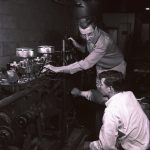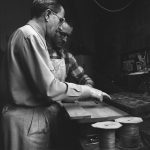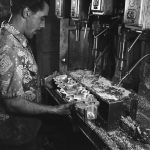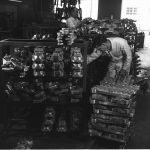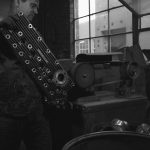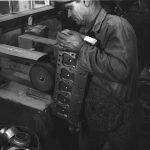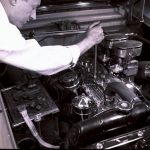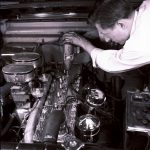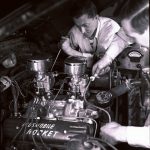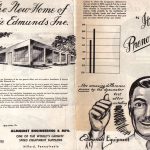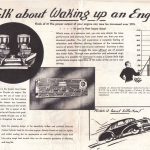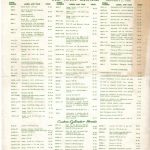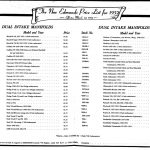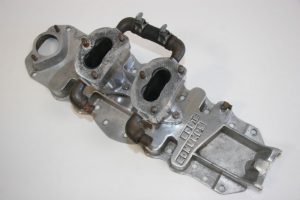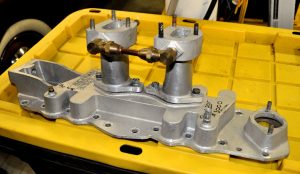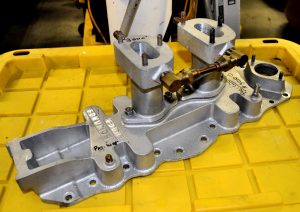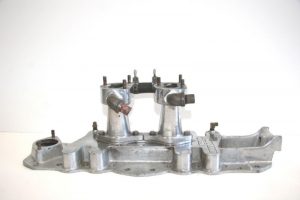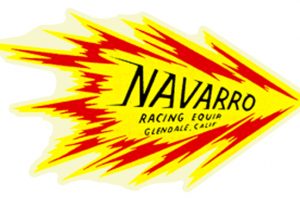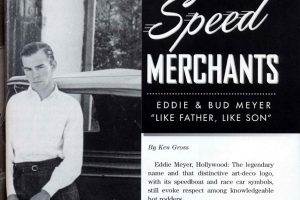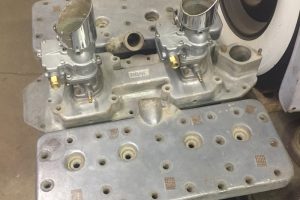Source: Roy Pagnini blog on Mr. Edmunds – http://eddie-edmunds.blogspot.com
Eddie Edmunds —–Edmunds Custom
Date of birth 18 feb. 1916 —- Date of death Sept 1969
Portland Oregon History:
1932, 1934 Polk Directory: Eddie Edmunds, mechanic, (Maryann) lived in an apartment on SW Morrison/17th.
1935 Polk Directory: Eddie Edmunds, auto repair for Montgomery Garage, (Maryann), lived at 1024 SW Harrison #46
1937 Polk Directory: auto repair at 35 NW 20th Pl [no business name provided], a property which he owned and at which he lived.
1938 Polk Directory: Same business info, but living at 309 N. Stafford
GRESHAM SPEEDBOWL in Portland (aka Twelve Mile Speedbowl), ½ mile dirt oval, 1928-1937; 1950s, located on 12 Mile Road.
Eddie was a mechanic on a dirt track car in the 1930’s before he got into the business of manufacturing intakes and heads.
He started making his intakes in Portland in the 30s and the 40s. After several years of manufacturing there, He decided to move to Southern California where there were more mold makers and aluminum smelters. Also the manual labor involved in the casting and polishing was much cheaper in southern California.
According to Glen Volz, of Salem speed shop in Oregon,(the oldest speed shop in the U.S. still in operation by its original owner) when Eddie first moved to L.A. he was manufacturing his speed equipment in a garage and doing most of the work himself. His wife Maryann, was a graphics artist and this was probably the reason his signature on his heads and manifolds were constantly changing. She also designed all of his ads and as you can see on the many examples on this blog, they were very different from the normal ads of the times.
After WW2 he applied for and was granted a Reconstruction Finance loan to expand his business and he purchased a large warehouse on Stoner Avenue in L.A.
On Stoner, half of the plant was dedicated to manufacturing and the other half to modifying vehicles as shown in the following article from Popular Mechanics.
His aim was never to manufacture speed equipment for the hot rod market, but to make it for the ordinary guy to get more performance out of his car.
One of his things was to install his equipment on movie stars vehicles for the publicity it generated.
It was said that he applied for and was granted a contract with the government (part of the reason for his loan being approved) for hopped up Cadillac engines to be used in tanks, but they never met the promised standards, the government had set and this is one of the reasons he defaulted on his loan and went bankrupt.
Also in the late 40s or early 50s he got involved in installing air conditioning units into high end cars, which led to his losing interest in the speed equipment end of the business.
According to Ed Iskendarian,whatever the cause most of his equipment was auctioned off. A good portion was purchased by Aaron Fenton and resold or scrapped under the Fenton name.
Apparently he was quite a character, and didn’t make his stuff in large amounts before changing designs, but quality suffered sometimes and designs weren’t tested. The nice thing about Edmunds is that he made an intake for every american engine, and a head for every flathead engine.
If you really want to be sick, in 1970, R&C magazine ran an article about Fenton Mfg. They were into shifters and mag wheels by then, but a picture of the rear of the Fenton building shows a mountain (literally) of discarded Fenton headers and Edmunds intakes and heads that probably eventually ended up being melted down.
The one thing for sure that I know about Eddie Edmunds is, he was very hard to obtain information about, I could not even obtain a death certificate from Los Angeles for the man. I know he died there in 1969, but he was possibly buried elsewhere hence no death certificate.
As to his vocation in life, He was completely dedicated, and for him to accomplish as much as he did in such a short period of time ( 53 years ) is also a testament to the help he received from his wife and several other family members (He had a cousin in the Portland area as his local sales rep. The cousin was into logging and the lumber business west of Portland, but he traveled the northwest selling Edmunds speed equipment.) .
If it wasn’t for Glen Volz and Ed Iskendarian what little I do have could not have been verified. Also I was recently informed that he has a son living somewhere in Minnesota, so like a dog with a bone, I am going to try and track him down. I started this whole story after an approximately 12 year search for some Edmunds speed equipment to install on a 1936 Pontiac straight 8. I remember seeing a setup on a poncho 8 that was racing dirt track when I was 12 years old (circa 1955). I was impressed by the way it sounded compared to a V8 of that era. I believe those engines weigh almost a thousand pounds with tranny, hence the name “boat anchor”. Anyhow thanks to the wonderful internet I actually found a dual carb manifold with brand new carter carbs (in western auto cardboard boxes) , a finned aluminum Edmunds head and re-curved distributor, 6 volt bus coil etc. (pictures to come). I hesitated about purchasing the above items because they were fairly expensive. This was mentioned to my wife and son at the time and I put the purchase on the back burner. When they appeared under the Christmas tree I was really surprised, it also took another three years before they were finally installed on the car. I believe this is the last set in existence for this straight 8. Anyhow this has all been a labor of appreciation for Eddie and his accomplishments I hope I have shown him some of the respect I think he deserves.
Edmund’s Custom is a registered trademark of Charlie Price-Vintage Speed- U.S. reg.#3,113,442
Special thanks to Roy Pagnini for his work on the Edmunds story.
A second post found on the HAMB said this.
Eddie was a mechanic on a dirt track car in the 1930’s before he got into the business of manufacturing intakes and heads.
He started making his intakes in Portland in the 30s and the 40s. After several years of manufacturing there, He decided to move to Southern California where there were more mold makers and aluminum smelters. Also the manual labor involved in the casting and polishing was much cheaper in southern California.
According to Glen Volz, of Salem speed shop in Oregon,(the oldest speed shop in the U.S. still in operation by its original owner) when Eddie first moved to L.A. he was manufacturing his speed equipment in a garage and doing most of the work himself. His wife Maryann, was a graphics artist and this was probably the reason his signature on his heads and manifolds were constantly changing. She also designed all of his ads and as you can see on the many examples on this blog, they were very different from the normal ads of the times.
After WW2 he applied for and was granted a Reconstruction Finance loan to expand his business and he purchased a large warehouse on Stoner Avenue in L.A.
On Stoner, half of the plant was dedicated to manufacturing and the other half to modifying vehicles as shown in the following article from Popular Mechanics.
His aim was never to manufacture speed equipment for the hot rod market, but to make it for the ordinary guy to get more performance out of his car.
One of his things was to install his equipment on movie stars vehicles for the publicity it generated.
It was said that he applied for and was granted a contract with the government (part of the reason for his loan being approved) for hopped up Cadillac engines to be used in tanks, but they never met the promised standards, the government had set and this is one of the reasons he defaulted on his loan and went bankrupt.
Also in the late 40s or early 50s he got involved in installing air conditioning units into high end cars, which led to his losing interest in the speed equipment end of the business.
According to Ed Iskendarian,whatever the cause most of his equipment was auctioned off. A good portion was purchased by Aaron Fenton and resold or scrapped under the Fenton name.
Apparently he was quite a character, and didn’t make his stuff in large amounts before changing designs, but quality suffered sometimes and designs weren’t tested. The nice thing about Edmunds is that he made an intake for every American engine, and a head for every Flathead engine.
If you really want to be sick, in 1970, R&C magazine ran an article about Fenton Mfg. They were into shifters and mag wheels by then, but a picture of the rear of the Fenton building shows a mountain (literally) of discarded Fenton headers and Edmunds intakes and heads that probably eventually ended up being melted down.
The one thing for sure that I know about Eddie Edmunds is, he was very hard to obtain information about, I could not even obtain a death certificate from Los Angeles for the man. I know he died there in 1969, but he was possibly buried elsewhere hence no death certificate.
As to his vocation in life, He was completely dedicated, and for him to accomplish as much as he did in such a short period of time ( 53 years ) is also a testament to the help he received from his wife and several other family members (He had a cousin in the Portland area as his local sales rep. The cousin was into logging and the lumber business west of Portland, but he traveled the northwest selling Edmunds speed equipment.) .
If it wasn’t for Glen Volz and Ed Iskendarian what little I do have could not have been verified. Also I was recently informed that he has a son living somewhere in Minnesota, so like a dog with a bone, I am going to try and track him down. I started this whole story after an approximately 12 year search for some Edmunds speed equipment to install on a 1936 Pontiac straight 8. I remember seeing a setup on a poncho 8 that was racing dirt track when I was 12 years old (circa 1955). I was impressed by the way it sounded compared to a V8 of that era. I believe those engines weigh almost a thousand pounds with tranny, hence the name “boat anchor”. Anyhow thanks to the wonderful internet I actually found a dual carb manifold with brand new carter carbs (in western auto cardboard boxes) , a finned aluminum Edmunds head and re-curved distributor, 6 volt bus coil etc. (pictures to come). I hesitated about purchasing the above items because they were fairly expensive. This was mentioned to my wife and son at the time and I put the purchase on the back burner. When they appeared under the Christmas tree I was really surprised, it also took another three years before they were finally installed on the car. I believe this is the last set in existence for this straight 8. Anyhow this has all been a labor of appreciation for Eddie and his accomplishments I hope I have shown him some of the respect I think he deserves.
THE EDMUNDS CUSTOM HIGHRISE 2×2
 Status: No longer in Production
Status: No longer in Production
This is one of the more rare intakes. I have not been able to find much information on the intake or when it was in production so I was hoping someone might be able to help fill in the gaps.
The Edmunds 2×2

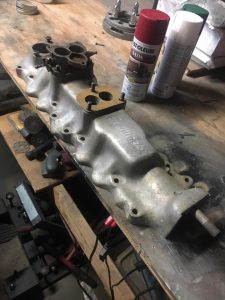 Status: No longer in production.
Status: No longer in production.
This set back 2×2 intake has a good form to it and is not as blocky as the other intakes. Its set back design allows for good generator clearance.
THE
1949-53 EDMUNDS 2×2
![]()
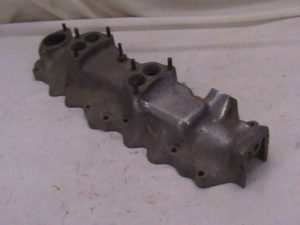 Status: No longer in production
Status: No longer in production
 Not much information regarding this intake.
Not much information regarding this intake.
THE BLOCK STYLE EDMUNDS 2×2
![]()
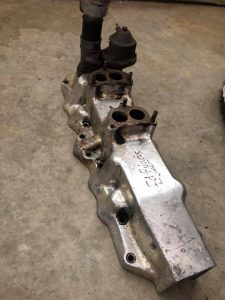 Status: No longer in production
Status: No longer in production
 I’m not a big fan of this design because of the almost two by four style of the intakes nose. These intakes are becoming more popular and prices are all over the board.
I’m not a big fan of this design because of the almost two by four style of the intakes nose. These intakes are becoming more popular and prices are all over the board.
Value: $350 – $400
These have been on the rise which is funny given how crude the design and common they are. In Sept of 2018 I have been seeing them go for as much as $500. Which I find shocking.
THE EDMUNDS 4brl
![]()
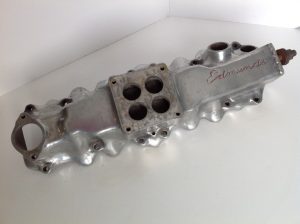 Status: No longer in production
Status: No longer in production
 I have only seen a few of these and they do seem to be quite rare. But don’t seem to have much value as the 4brl intakes are generally not as desirable with a Nostalgic market.
I have only seen a few of these and they do seem to be quite rare. But don’t seem to have much value as the 4brl intakes are generally not as desirable with a Nostalgic market.
THE
EDMUNDS 2×2 – For Lincoln 337 – V8
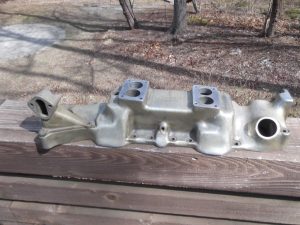
 Status: No longer in production
Status: No longer in production
Not much information regarding this intake.
THE
EDMUNDS 2×2 – For V860
![]()
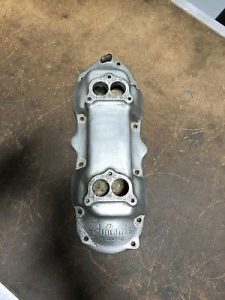
 Status: No longer in production
Status: No longer in production
Not much information regarding this intake.
THE
EDMUNDS 2×2 – For Flathead Inline 6
![]()
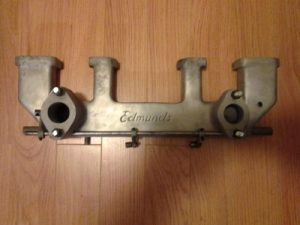
 Status: No longer in production
Status: No longer in production
Not much information regarding this intake.
Value: $200-250 on ebay.



